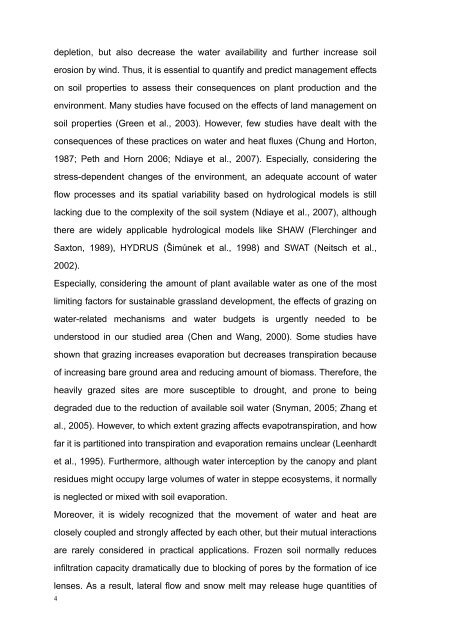SCHRIFTENREIHE Institut für Pflanzenernährung und Bodenkunde ...
SCHRIFTENREIHE Institut für Pflanzenernährung und Bodenkunde ...
SCHRIFTENREIHE Institut für Pflanzenernährung und Bodenkunde ...
Create successful ePaper yourself
Turn your PDF publications into a flip-book with our unique Google optimized e-Paper software.
depletion, but also decrease the water availability and further increase soil<br />
erosion by wind. Thus, it is essential to quantify and predict management effects<br />
on soil properties to assess their consequences on plant production and the<br />
environment. Many studies have focused on the effects of land management on<br />
soil properties (Green et al., 2003). However, few studies have dealt with the<br />
consequences of these practices on water and heat fluxes (Chung and Horton,<br />
1987; Peth and Horn 2006; Ndiaye et al., 2007). Especially, considering the<br />
stress-dependent changes of the environment, an adequate account of water<br />
flow processes and its spatial variability based on hydrological models is still<br />
lacking due to the complexity of the soil system (Ndiaye et al., 2007), although<br />
there are widely applicable hydrological models like SHAW (Flerchinger and<br />
Saxton, 1989), HYDRUS (Šimůnek et al., 1998) and SWAT (Neitsch et al.,<br />
2002).<br />
Especially, considering the amount of plant available water as one of the most<br />
limiting factors for sustainable grassland development, the effects of grazing on<br />
water-related mechanisms and water budgets is urgently needed to be<br />
<strong>und</strong>erstood in our studied area (Chen and Wang, 2000). Some studies have<br />
shown that grazing increases evaporation but decreases transpiration because<br />
of increasing bare gro<strong>und</strong> area and reducing amount of biomass. Therefore, the<br />
heavily grazed sites are more susceptible to drought, and prone to being<br />
degraded due to the reduction of available soil water (Snyman, 2005; Zhang et<br />
al., 2005). However, to which extent grazing affects evapotranspiration, and how<br />
far it is partitioned into transpiration and evaporation remains unclear (Leenhardt<br />
et al., 1995). Furthermore, although water interception by the canopy and plant<br />
residues might occupy large volumes of water in steppe ecosystems, it normally<br />
is neglected or mixed with soil evaporation.<br />
Moreover, it is widely recognized that the movement of water and heat are<br />
closely coupled and strongly affected by each other, but their mutual interactions<br />
are rarely considered in practical applications. Frozen soil normally reduces<br />
infiltration capacity dramatically due to blocking of pores by the formation of ice<br />
lenses. As a result, lateral flow and snow melt may release huge quantities of<br />
4


